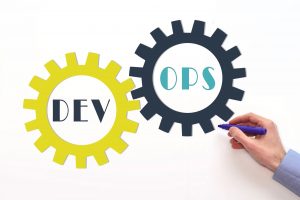
Want to Know How to Pull Off a Successful DevOps Implementation?
Posted by Walid Abou-Halloun Date: May 19, 2018 10:47:40 AM
In this day and age, a vast majority of businesses are undergoing some form of digital transformation as they begin to shift ideas from concept to reality. The integration of digital technology into all areas of the business is centred around modernising and digitalising the business and it’s processes.
In the current enterprise market, 85% of businesses have a multi-cloud environment.
Digital transformation isn’t coming: it’s here.
Over the years, this emerging trend has created a need for developers who can work within the cloud. Out of that need, DevOps was born.
But DevOps isn’t just a role that any enterprise can bring into the fold of their existing organisation. It’s a cultural shift that challenges old organisational models and ways of thinking.
Here’s what you need to know to pull off a successful DevOps implementation.
Why DevOps?
“If it’s not broken don’t fix it” isn’t really a winning strategy in the enterprise marketplace. It’s a climate where the newer the technology, the more cutting-edge the industry leaders are perceived.
In addition to the normal growing pains that come along with adapting to new technology in a work environment, most companies find that investments in technology are necessary for taking on the competition.
But Why a DevOps Implementation?
For one, DevOps is centrally focused on continuous delivery. This grew out of the need developers have for frequent releases to keep them ahead of the competition.
High profile enterprises from Walmart to Nordstrom, and even Amazon, have taken a DevOps approach to their organisations. Those who decide on DevOps implementation are in good company.
A major selling point of DevOps culture is business agility. In many ways, DevOps and Agile overlap.
Think of DevOps as the larger cultural shift within an organisation and it’s founded on a framework that includes Agile principles, like SCRUM.
These founding principles help companies stay organised while continuously delivering high-quality work. But it also helps teams plan for the unplannable, a concept that isn’t addressed with Agile alone.
Expect Big Changes
Companies who don’t prepare for a cultural shift with their DevOps implementation fail 90% of the time.
One goal of DevOps is to change how operations and developers interact with one another—a change that’s intended to help departments flourish with healthy competition.
Historically, Development and Operations are two departments that have different, if not conflicting, operational ideologies. But cooperation between the departments is necessary for any organisation to succeed.
Like its name implies, DevOps bridges the gap between development and operations.
But it’s a gap that’s sometimes wide. Businesses getting into DevOps should expect some bumps in the road. Prepare to apply a clean set of metrics that’s the same for measuring the performance of both Development and Operations teams.
Sample DevOps Implementation Plan
When implementing DevOps it’s advisable that you do small to medium implementations and scale outward in your organisation.
At each level, you can fulfill these steps, or you can work them in groups with team leads over clusters of implementations.
Below is your one-stop implementation plan:
Step 1: Readiness Planning
In this stage, the organisation is surveyed for readiness, and top executives come on board to sponsor and navigate the cultural shift. The output at this step is strategic and high-level.
Step 2: Lead with a Center of Excellence (CoE)
A CoE for your DevOps shift is considered the trailblazer of this change, establishing guidelines pivotal in implementing a culture shift.
The lead sponsor in this group should be at the executive level and someone who can reach across and unite all departments, whether that be a CEO or someone else in the C-suite like a technology officer.
The members of this team should represent the full organisation, and even vendors, and should be carefully chosen as people who can embrace and make an impact on company culture.
During this step, you will establish program governance that will drive culture forward.
Step 3: Create a Project Workflow
The most central staple in DevOps culture is developing an inbound project workflow. This is an organised intake process that makes or breaks a sprint.
Setting intake goals that support continuous delivery helps early DevOps adopters stay organised.
Step 4: Select Pilot Groups
It’s recommended you start DevOps implementation with small to medium-sized groups. Learn about what works for your company and implement in an organised, agile way.
The pioneers of the Center of Excellence will select teams for DevOps transition.
Step 5: Scale
Continue to follow the steps until the entire organisation has transitioned.
Transitioning to DevOps isn’t easy. Teams will likely face challenges but these five steps help simplify the process.
Tips for a Successful Implementation
Now that you understand why DevOps is good for your organisation, you’re probably planning to implement it as soon as possible. So, what’s next?
Business leaders can use these tips when moving to a DevOps organisational strategy:
Tip 1: Consider a New Operating Model
This is a big change, but DevOps is a cultural shift that needs to take place at all levels of an organisation. Ask yourself: is your current model set up to encourage departmental interdependence, communication, and continuous delivery?
If not, it may be time to adopt a new operating model.
Tip 2: Is Your Tech Ready for the Transition?
The days of big, gloomy server rooms are over!
That equipment and the often outdated software infrastructures that enterprise businesses keep around don’t make for an Agile culture. Ditch the old equipment for a multi-cloud environment and software tools like Agile accelerators.
Tip 3: Set the Right Metrics
Taking on a DevOps shift means moving to an outcome-focused thinking. Metrics should reflect the maturity of agile groups within an organisation, as opposed to traditional metrics.
Tip 4: Put Your Money Where Your Mouth Is
Among the investments that need to be made, no small consideration is investing in efforts that promote a DevOps culture.
New roles will need to be created across organisations, and they will need to be filled with DevOps- minded people. This means possibly investing in new staff, and definitely in training, software, and equipment.
Tip 5: Open Up to New Thinking About Your Budget
In a traditional budget, measurable outcomes are thought to be project time and cost. In a DevOps organisation, the budget will need to be based on leading with innovative and achieving desired outcomes. It’s much more like a Venture capitalist’s approach to funding; then it is a CFO’s approach to budgeting.
Tip 6: Don’t Switch Unless You’ll Benefit from It
Some organisations are simply not ready for a DevOps transition. Yes, it’s the way enterprise businesses are going. It’s the future of development.
But if your business can’t commit 100% to the change in culture for whatever reason, don’t do it. It can be an expensive mistake.
Consider what you stand to gain from DevOps culture before making the switch.
Tip 6: Start Small, Go Big
A theme that comes up throughout this discussion is the need to start small and work your way into a bigger cultural shift.
This means breaking out teams, getting key stakeholders on board, and resetting metrics and expectations. The list is exhausting. Don’t try to make all the changes at once.
Allow DevOps culture to grow ORGANICALLY with your organisation
Tip 7: Automate and Integrate for Continuous Delivery
Having the right hardware and software in place means having solutions that automate and integrate.
These functions are a key part of DevOps culture because they set developers up for successful continuous delivery.
If this is outside of your comfort zone, consider a consultant when making decisions about software to automate and integrate.
Tip 8: Plan for Monitoring and Feedback
Among the systems that will need to be built up within your organisation are those that allow for monitoring and feedback throughout the project delivery process.
Communicationis important throughout this process. And with a heavy-handed approach to automation, monitoring with alerts being sent to project stakeholders is critical to success.
Using these tips, you can begin to navigate the daunting world of digital transformation.
How to Implement DevOps
Implementing DevOps requires an investment of time, resources, and budget.
Enterprise businesses preparing for a full-scale DevOps implementation should avoid rushing the process. Plenty of planning and research can help overcome challenges.
DevOps changes will be incurred throughout the organisation. Any culture shift needs to come from the top down.
Navigating a shift to DevOps can be tricky for enterprise business leaders who choose to do it alone.
Contact us today to learn how we can help your organisation with a DevOps transition.




